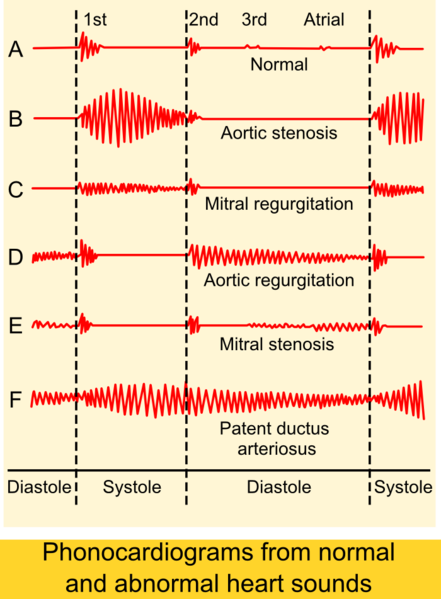Diastolic heart murmur
Jump to navigation
Jump to search

Editor-In-Chief: C. Michael Gibson, M.S., M.D. [1]
Overview
Diastolic heart murmurs are heart murmurs heard during diastole.[1][2][3]Diastolic murmurs start at or after S2 and end before or at S1. Many involve stenosis of the atrioventricular valves or regurgitation of the semilunar valves.
Types
- Early diastolic murmurs start at the same time as S2 with the close of the semilunar (aortic & pulmonary) valves and typically end before S1. Common causes include aortic or pulmonary regurgitation and left anterior descending artery stenosis.
- Mid-diastolic murmurs start after S2 and end before S1. They are due to turbulent flow across the atrioventricular (mitral & tricuspid) valves during the rapid filling phase from mitral or tricuspid stenosis.
- Late diastolic (presystolic) murmurs start after S2 and extend up to S1 and have a crescendo configuration. They can be associated with AV valve narrowing.[4] They include mitral stenosis, tricupsid stenosis, myxoma, and complete heart block.
Individual murmurs
| Time | Condition | Description |
|---|---|---|
| Early diastolic | Aortic regurgitation | The murmur is low intensity, high-pitched, best heard over the left sternal border or over the right second intercostal space, especially if the patient leans forward and holds breath in full expiration. The radiation is typically toward the apex. The configuration is usually decrescendo and has a blowing character. The presence of this murmur is a good positive predictor for AR and the absence of this murmur strongly suggests the absence of AR. An Austin Flint murmur is usually associated with significant aortic regurgitation. |
| Early diastolic | Pulmonary regurgitation | Pulmonary regurgitation is most commonly due to pulmonary hypertension (Graham-Steell murmur). It is a high-pitched and blowing murmur with a decrescendo configuration. It may increase in intensity during inspiration and best heard over left second and third intercostal spaces. The murmur usually does not extend to S1. |
| Early diastolic | Left anterior descending artery stenosis | This murmur, also known as Dock's murmur, is similar to that of aortic regurgitation and is heard at the left second or third intercostal space. A Coronary artery bypass surgery can eliminate the murmur. |
| Mid-diastolic | Mitral stenosis | This murmur has a rumbling character and is best heard with the bell of the stethoscope in the left ventricular impulse area with the patient in the lateral decubitus position. It usually starts with an opening snap. In general, the longer the duration, the more severe the mitral stenosis. However, this rule can be misleading in situations where the stenosis is so severe that the flow becomes reduced, or during high-output situations such as pregnancy where a less severe stenosis may still produce a strong murmur. In mitral stenosis, tapping apical impulse is present. |
| Mid-diastolic | Tricuspid stenosis | Best heard over the left sternal border with rumbling character and tricuspid opening snap with wide splitting S1. May increase in intensity with inspiration (Carvallo's sign). Tricuspid stenosis often occurs in association with mitral stenosis. Isolated TS are often associated with carcinoid disease and right atrial myxoma. |
| Mid-diastolic | Atrial myxoma | Atrial myxomas are benign tumors of the heart. Left myxomas are far more common than right myxomas and those may cause obstruction of the mitral valve producing a mid-diastolic murmur similar to that of mitral stenosis. An echocardiographic evaluation is necessary. |
| Mid-diastolic | Increased flow across the atrioventricular valve | This can also produce a mid-diastolic murmur, such as in severe mitral regurgitation where a large regurgitant volume in the left atrium can lead to "functional mitral stenosis." |
| Mid-diastolic | Austin Flint murmur | An apical diastolic rumbling murmur in patients with pure aortic regurgitation. This can be mistaken with the murmur in mitral stenosis and should be noted by the fact that an Austin Flint murmur does not have an opening snap that is found in mitral stenosis. |
| Mid-diastolic | Carey-Coombs murmur | A mid-diastolic murmur over the left ventricular impulse due to mitral valvulitis from acute rheumatic fever. |
| Late diastolic (presystolic) | Complete heart block | A short late diastolic murmur can occasionally be heard (Rytand's murmur). |
2008 and Incorporated 2006 ACC/AHA Guidelines for the Management of Patients with Valvular Heart Disease (DO NOT EDIT) [5]
Echocardiography in Diastolic Heart Murmur (DO NOT EDIT) [5]
| Class I |
|
"1. Echocardiography is recommended for asymptomatic patients with diastolic murmurs, continuous murmurs, holo-systolic murmurs, late systolic murmurs, murmurs associated with ejection clicks or murmurs that radiate to the neck or back. (Level of Evidence: C)" |
Sources
- 2008 Focused Update Incorporated Into the ACC/AHA 2006 Guidelines for the Management of Patients With Valvular Heart Disease [5]
References
- ↑ Template:DorlandsDict
- ↑ "Diastolic Murmurs -- Clinical Methods -- NCBI Bookshelf". Retrieved 2008-12-31.
- ↑ "Techniques - Heart Sounds & Murmurs Exam - Physical Diagnosis Skills - University of Washington School of Medicine". Retrieved 2009-03-06.
- ↑ Template:DorlandsDict
- ↑ 5.0 5.1 5.2 Bonow RO, Carabello BA, Chatterjee K; et al. (2008). "2008 Focused update incorporated into the ACC/AHA 2006 guidelines for the management of patients with valvular heart disease: a report of the American College of Cardiology/American Heart Association Task Force on Practice Guidelines (Writing Committee to Revise the 1998 Guidelines for the Management of Patients With Valvular Heart Disease): endorsed by the Society of Cardiovascular Anesthesiologists, Society for Cardiovascular Angiography and Interventions, and Society of Thoracic Surgeons". Circulation. 118 (15): e523–661. doi:10.1161/CIRCULATIONAHA.108.190748. PMID 18820172. Unknown parameter
|month=ignored (help)
Template:Eponymous medical signs for circulatory and respiratory systems